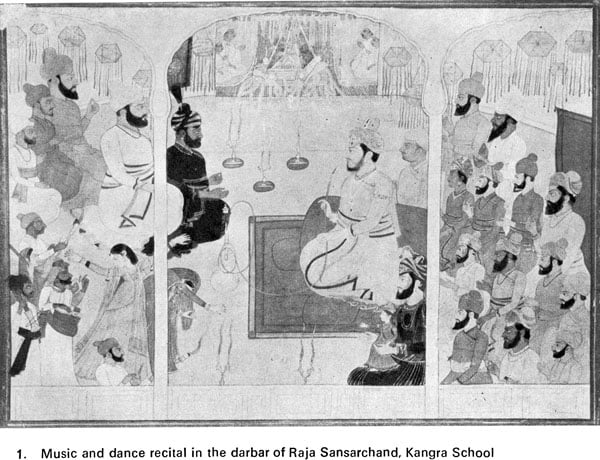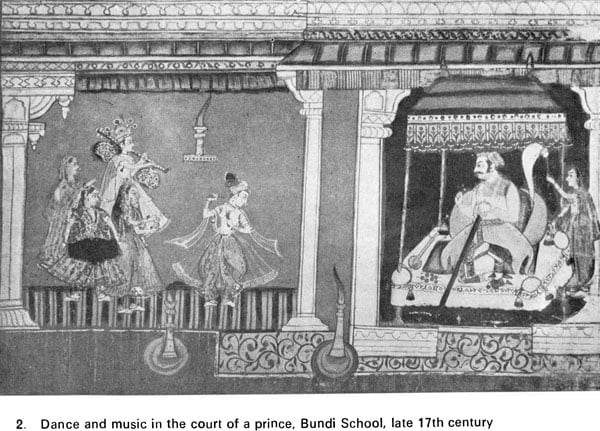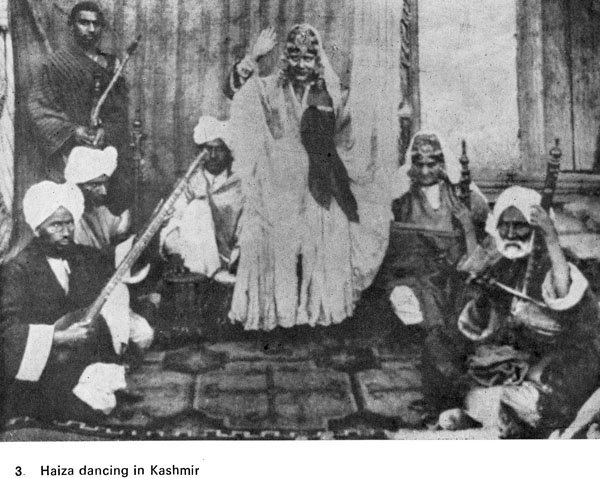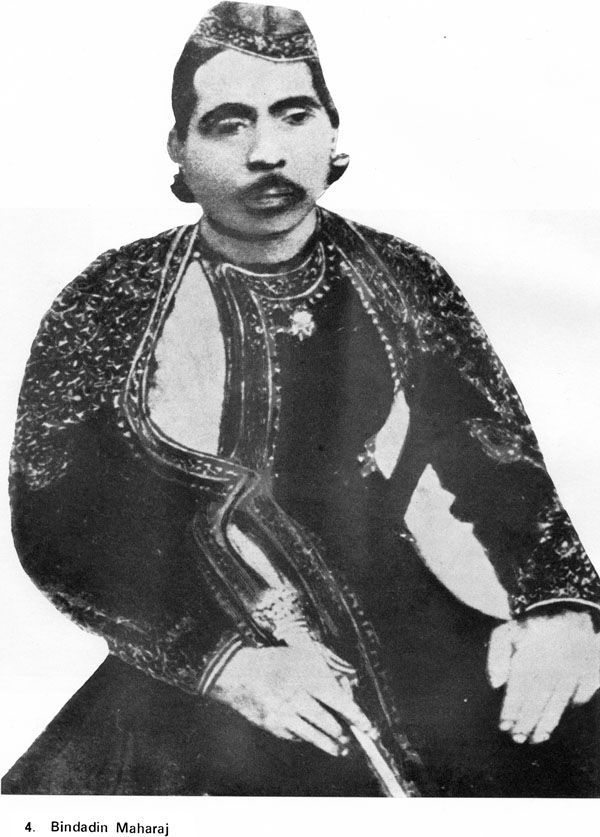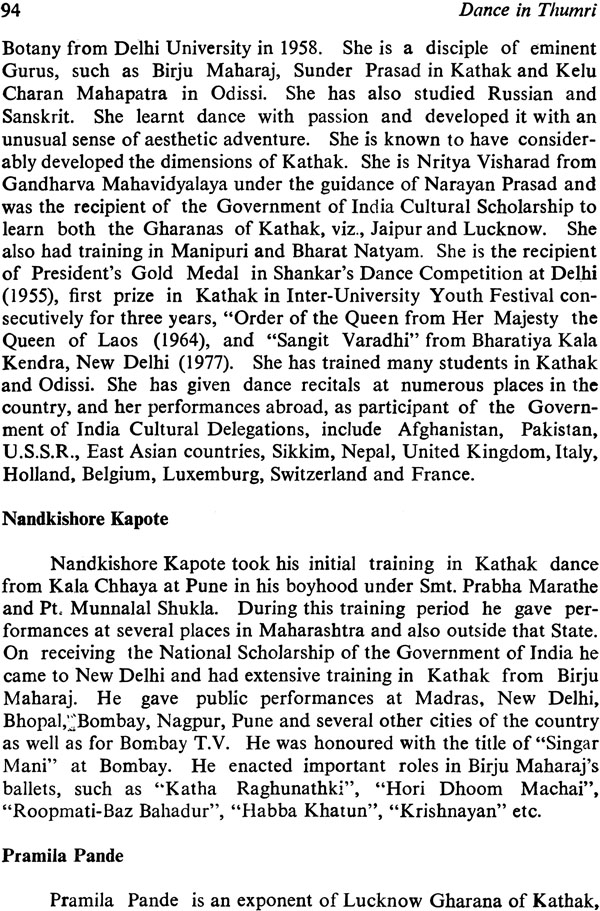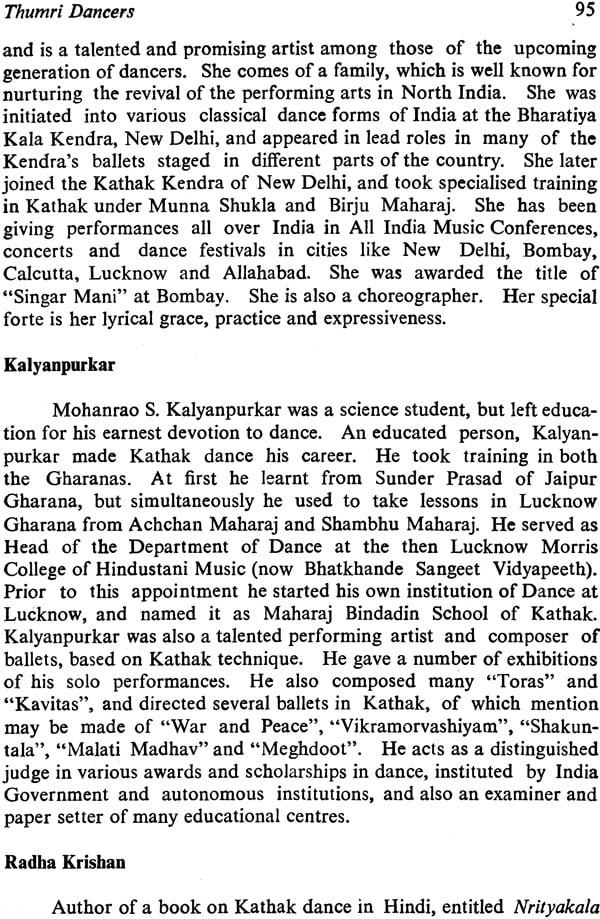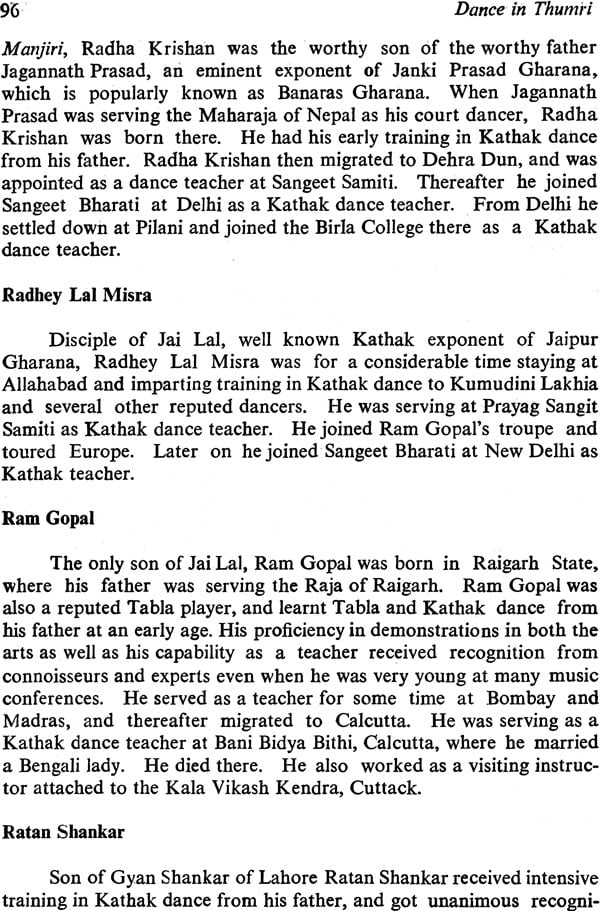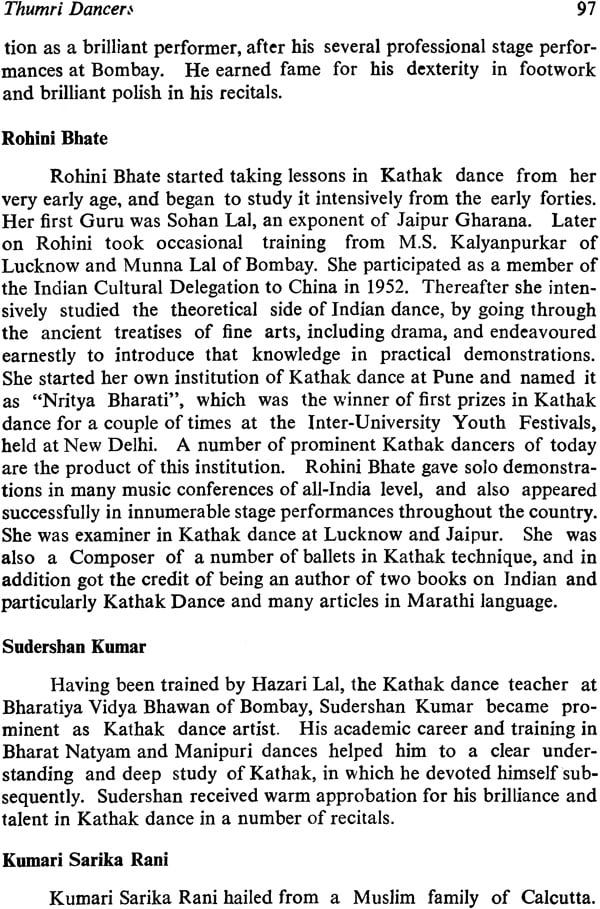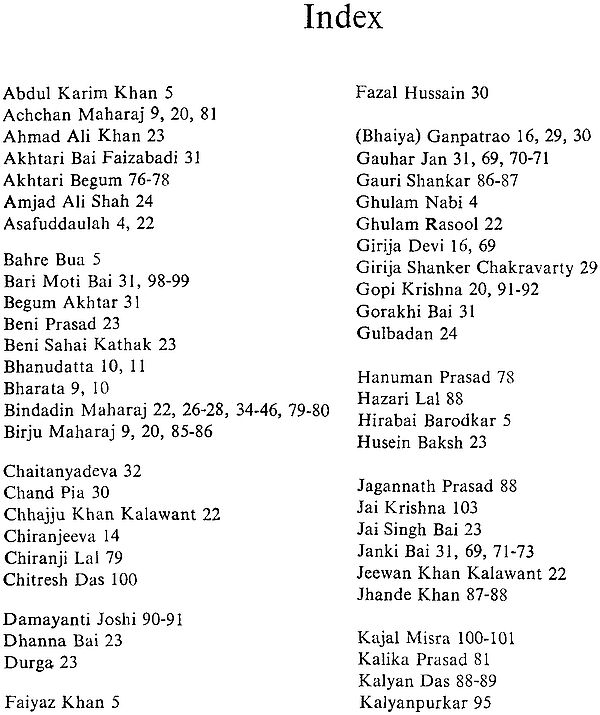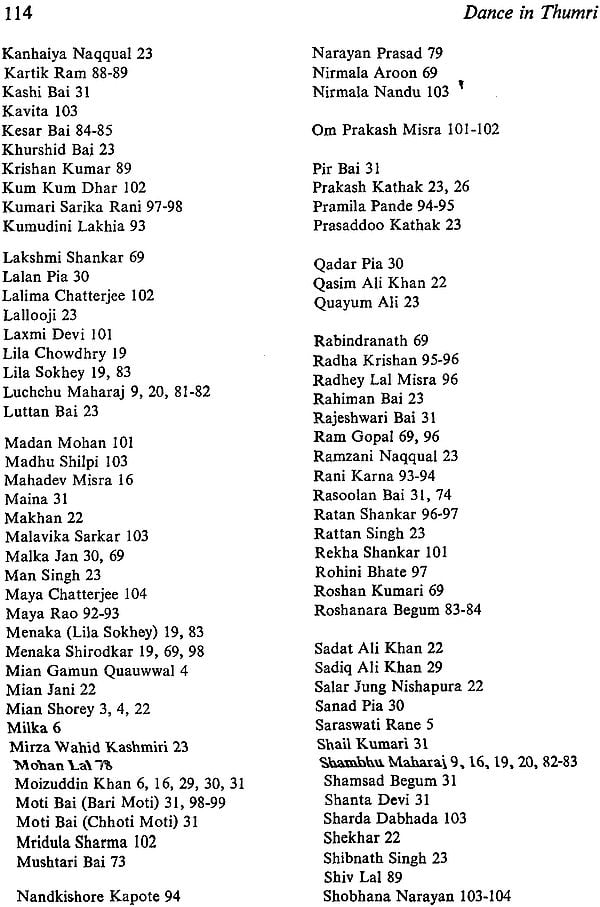
DANCE IN THUMRI
Book Specification
| Item Code: | IDG501 |
| Author: | PROJESH BANERJEE |
| Publisher: | ABHINAV PUBLICATION |
| Language: | English |
| Edition: | 1986 |
| ISBN: | 8170172128 |
| Pages: | 123 (B & W Illus: 27) |
| Cover: | Hardcover |
| Other Details | 9.6" X 7.5" |
| Weight | 490 gm |
Book Description
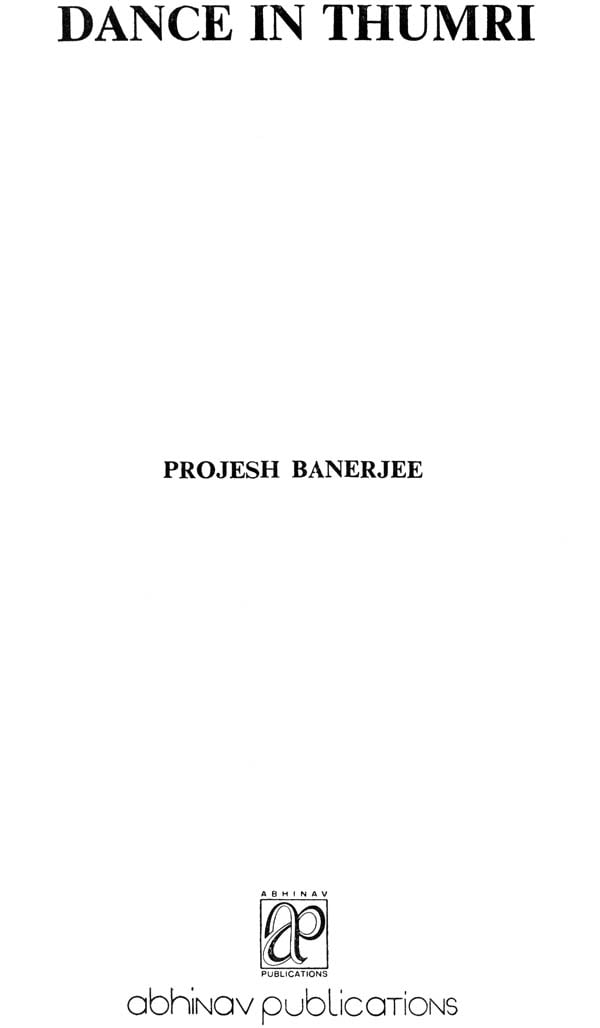
About the Book :
The book narrates the story of the sad, rather step-motherly treatment meted out by orthodox musicians to Thumri-especially their castigation of Thumri as a dance form. Such apathy and castigation stem from a colonial milieu and the education that went with it. For all practical purposes not only is the Thumri's dance portion too often totally ignored, but it is even considered superfluous! The author impresses on the reader the close link between the dance and the music. Such at least was the indissoluble union of style in the past. The author hopes that the book will correct this disturbed relationship. As such the work is of immense artistic importance.
About the Author:
The author of the book is not only a reputed art critic, but also a balletomane himself, having in the early forties produced and directed a number of ballets-including children's ballets. His key contribution in some of the children's ballets was balletmusic on percussions. Projesh Banerjee's devotion to the study of Indian Dancing as well as to its revival goes back to the 1930s-a period when little was known of India's dance tradition by the educated public. His first work, an encyclopedia of India dance, entitled Dance of India, was published in 1941, followed by other. He was intimately connected with Uday Shankar Co.Ltd. for some time. He also acted as impresario for a number of other acknowledge dancers of first rank and extensively traveled in this connection. His deep absorption in the fine arts Made him a successful dance teacher. Projesh Banerjee sarved as juror for assessment of dance at All India Music Conferences, All India Drama Competitions, as also on the Public Service Commission, the All India radio etc. He has also served as Principal, B.T. College, run by Prayag Sangit Samiti, Allahabad.
It is a pity that in their performance, Kathak dancers too often dwell on the rhythmic dexterity of the intricate time measurements of the Tala and its permutations and combinations. The time patterns are so woven that they lead one to the minutest fractions, in other words, ciphers. This is the main picture, or almost so. And a profile is painted with the numberless pirouettes- those full blossomed swayings and wavings of the Lahanga. Thereafter follows the speediest tempo climaxing the performance with a thud on the Sum of the Tala, or the unit from where it all begins, finishing off with a long three equal piece phrase of the metre. The entire performance amounting to a splendid, very polished acrobatic feat. There is, as a consequence, that well known dinning applause from the spectators, much as if the spectators had enjoyed a nervousness causing trapeze or a somersault trick by an expert gymnast –mouths agape.
Undoubtedly, artistes alone are not to be blamed for this situation. They have to cater to the spectators' whims –call them tastes. But had such tastes not better be carefully groomed, that is, if the aim was to treat one to what is termed the beautiful? As a matter of fact a very significant feature of the style is usually left out by the performers, and this is the aesthetics of Kathak, the Kavita, its lyricism. Poetry plays a major role in Kathak dance, and which is provided by the Thumris, sung in accompaniment of the dance. Previously the dancers immerse themselves in this aspect with vigour and enthusiasm, and indeed it used to be a compulsory facet of the performance, without which the dance remained incomplete. But now as this aspect is waning, the result can be well imagined.
It is only for this reason that I thought it expedient to dilate upon the Thumri phase in the splendours of Kathak, hoping thereby to bring out an all too precious nuance of the dance style.
To ward off certain misunderstanding from the minds of my readers, may I clarify at the outset (even though I have done so in the body of this book) that–broadly–dancing does not mean footwork alone; and of course along with it, body movements, hand gestures and facial expressions, but also facial expressions accompanied by hand movements while sitting and not making any footwork. Some of the Thumri singers whose primary forte was simply singing in the earlier part of their professional career used to express the meaning of the words of the Thumri songs and the various emotions of the lyrics through facial expressions, eye and hand movements, and particular mention among them may be made of Gauhar Jan, Janki Bai, Malka Jan, Rasoolan Bai, Akhtari Begum, Siddheswari Devi and certain others. Hence I have included their life sketches in this volume along with those of the dancers, whose primary execution was, and is, dancing.
This short preamble will not be complete without expressing my gratitude to all those who have given untold support in writing this book, and in particular to the Sangit Natak Akademi, New Delhi, for supplying several of the photographs included in the text.
| Preface | vii |
| 1. Thumri | 1 |
| 2. Lyricism and Nayikas | 8 |
| 3. Abhinaya in Thumri | 16 |
| 4. Nawab Wajid Ali Shah and Bindadin | 22 |
| 5. Contemporary Artists | 29 |
| 6. Thumri-Dance Songs | 32 |
| 7. Thumri Dancers | 69 |
| Appendix | 105 |
| Index | 113 |
